
Design a steampunk airship
Aimee needs help designing a
steampunk airship. Any takers? (Roland?)
For story reasons too
complicated to get into here, I'd like to have most or all of the
living quarters down in a gondola suspended below the balloon. So more
like the semirigid or nonrigid airships in the diagram above, although
I'm not actually set on it not having a rigid frame.
The Hindenburg had
capacity for 72 passengers and 40 crew members. It was 250 meters long
and 40 meters in diameter and used hydrogen gas to stay afloat.
I'm thinking of using
hydrogen gas in my story too despite (or perhaps because of) the fire  potential. How big do you
think my airship would have to be to need about 8 to 15 crew members
while having capacity for about 15 passengers (hotel-like setting, not
just seats) with an equal-sized cargo space?
potential. How big do you
think my airship would have to be to need about 8 to 15 crew members
while having capacity for about 15 passengers (hotel-like setting, not
just seats) with an equal-sized cargo space?
I'd like to create the
hydrogen in situ using Chlamydomonas
reinhardtii
algae, similar to Vincent
Callebaut's dream,
but built like a ship rather than a city. What kind of lightweight
medium would you grow algae on in an airship setup?
Here are a couple of
other diagrams that floated my boat. (Click on any image to find the
source of the pretty pictures.) Now I'm ready for your ideas --- go!
Want more in-depth information? Browse through our books.
Or explore more posts by date or by subject.
About us: Anna Hess and Mark Hamilton spent over a decade living self-sufficiently in the mountains of Virginia before moving north to start over from scratch in the foothills of Ohio. They've experimented with permaculture, no-till gardening, trailersteading, home-based microbusinesses and much more, writing about their adventures in both blogs and books.
Want to be notified when new comments are posted on this page? Click on the RSS button after you add a comment to subscribe to the comment feed, or simply check the box beside "email replies to me" while writing your comment.
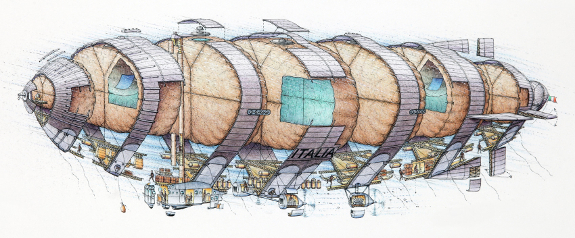
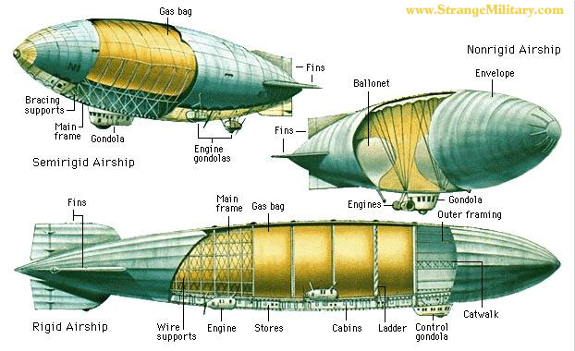
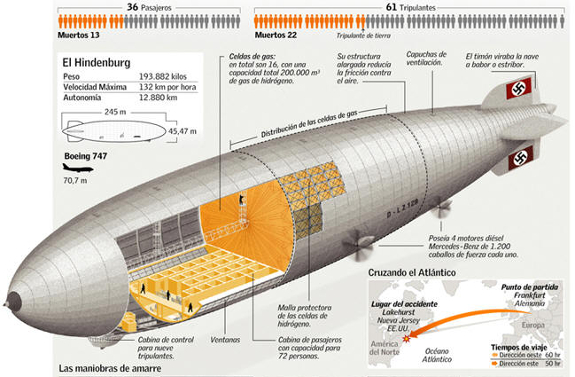
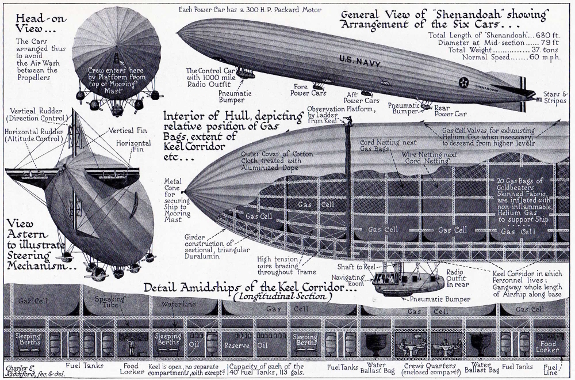
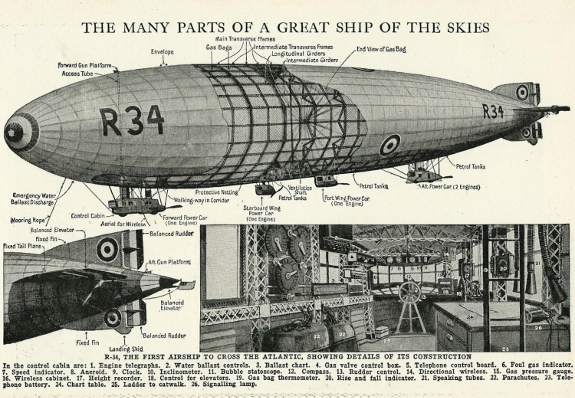

I wouldn't use hydrogen for a large dirigible like you're proposing. That would be too flammable as evidenced by the horrific destruction of the Hindenburg in 1937. (My mother recounted to me her hearing news reports of the disaster.)
I would use helium instead.
As far as Chlamydomonas reinhardtii algae is concerned, according to this abstract "The best producer of hydrogen is eukaryotes algae which contain the enzyme hydrogenase. The enzyme produces hydrogen as a waste product during metabolism. The goal of researchers working with algae is to take part of the enzyme which produces hydrogen and insert it into the plant’s photosynthesis framework, thereby coaxing the algae to produce significant amounts of hydrogen by-product." (From the International Journal of Hydrogen Energy found at: https://umexpert.um.edu.my/file/publication/00003241_82524.pdf) According to Wikipedia it's found in soil and water and I'm not sure how you would get enough soil and/or water on the ship to provide the necessary amount of hydrogen you would need to lift the ship off the ground. The Hindenberg had 7,062,000 cubic feet of hydrogen. That's a LOT of gas. (Maybe you can get a few politicians to be passengers? Their ramblings might give you enough gas! ha ha).
Just because you're writing a steampunk novel, doesn't mean that they didn't have technology that was as sophisticated as ours, it just went along a different path and I would think that they would've found a way to create enough helium for their needs. Even the Victorians had the ability to make helium.
Nevertheless, I am looking forward to seeing your novel. Will you be self-publishing or just doing fan fiction? BTW, I've betaed fan fiction.
I love the idea.
For inspiration I know just the place: Girl Genius. Steampunk, airships, mad science. (Start at the first page and prepare to get severely distracted. )
)
While airships seem primitive, they were actually state-of-the-art when they were introduced. The first Zeppelin, LZ1 (first flight 1900) had an aluminium frame long before this became common in airplanes. Airships pioneered lightweight engines, construction materials and techniques.
If you ever have the opportunity, a visit to the Zeppelin Museum in Friedrichshafen (Germany) is well worth it. In the museum you can walk through a partial full-scale replica of the Hindenburg. It's very impressive and looks modern even today. Mainly because almost everything is made out of aluminium.
And since you're filling your airship with flammable hydrogen, you might as well use flammable but lighter than aluminium magnesium alloys.
A very cool concept I seem to recall from a William Gibson novel was an airship “filled” with vacuum. That would give the best obtainable buoyancy. The trick is finding an enclosure that's light and doesn't implode!
But with a conventional airship, to carry 30 people and freight you're probably looking at something between (at least) an LZ-120 (710,000 cu ft) and LZ-126) (2,764,460 cu ft) depending on required cargo capacity and range. Blimps and semi-rigid airships are probably not big enough. And the internals of a rigid frame airship are a good setting for a story. I seem to recall an action/spy movie set in an airship.
But I very much doubt it could literally be steam-driven; steam engines require huge amount of water, and are also very heavy. German Zeppelins often used Maybach engines like this VL 2. It can produce 570 hp at a weight of 2,530 lb. That is 0.22 hp/lb. That's of course just the engine without a gondola and drivetrain. But even doubling the weight still gives around 0.11 hp/lb.
One of the most modern steam locomotives ever built, Tornado, weighs 105 long tons (235,200 lb) and produces 2000 kW (2681 hp). That's just 0.011 hp/lb. So the power/weight ratio of a steam engine is like a factor of ten worse than an internal combustion engine. And as an engineer, the idea of firing a steam engine under a huge bag of hydrogen gives me the willies!
If the airship is filled with hydrogen, it would be logical to use fuel cells to produce electricity to drive electric motors. Electric motors are very efficient, compact and can have very good power/weight ratios, up to 5 hp/lb.
From what I've seen, growing algae requires significant amount of water. That weight penalty probably makes it unpractical to generate hydrogen in-situ.
Of course since this is fiction you can mostly ignore technical realities when it suits you.
Hope this helps!
"Of course since this is fiction you can mostly ignore technical realities when it suits you." Roland
No.No.No. NO!!! Science fiction is about SCIENCE and TECHNOLOGY which means you can't be making this stuff up! If you really wish to ignore technical realities it is not longer "science fiction" but fantasy. Nothing wrong with fantasy but please! Don't call it science fiction.
(Is that a cool title or what? Dibs on the "weirdest comment title" award.)
@Anna: A zeppelin built with todays technology would almost certainly use carbon fiber composites for the frame and gondola because of its high streng/weight and stiffness/weight ratio. I'm not sure what to use for the gas bags. rip-stop nylon with a rubber or metalized coating?. Hydrogen being a very small molecule easily permeates through a lot of stuff.
I would think that the danger of a hydrogen filled airship could be reduced by filling the space between the gas bags and the outer shell with nitrogen instead of air; Hydrogen gas is only really dangerous in the presence of oxygen.
Further I would imagine that controls are servo-powered and partially automated (e.g. keeping trim, autopilot) etc.
The outside skin could consist of printed flexible solar cells to generate electricity when flying above the clouds.
@Nayan: A lot of good science fiction ignores technical realities in the name of "wouldn't it be cool if...". For example, the accelleration in the cannon used in Jules Vernes' From the eath to the moon (approx. 3,000 g's) would be well above survivable limits to put it mildly. And Larry Niven's Ringworld contains several concepts that are probably not possible given our current knowledge; scrith, General Products hulls, boosterspice and hyperdrive to name a few. Still, I would not qualify those as fantasy.
As you drift away from reality, it gets harder to keep your audience from drifting into cognitive dissonance. Assuming they know some science.
So, since you are not hard core on the Steampunk, or even if you are, justify your hydrogen in terms of the impending Helium Sunset.
In the past few billion years, deep in the Earth, atomic decay has created ALL the helium we have at our disposal, and every party balloon, and weather balloon, and superconducting magnet in an MRI machine, etc., eventually vents some of that dwindling resource into the atmosphere, where it drifts up and off into space. We're using it up at many, many orders of magnitude the rate at which the Earth produces it. Hence the term "sunset". Oil's got nothing on you, He.
(Oh, wait, we found some more in Tanzania, so, problem solved, right?)
The only way I know for people to "make more helium" happens in very tiny amounts in the heart of a hydrogen bomb. When it explodes, of course. And, oh yeah, in the vast number of fusion reactors they've been promising us for decades.
Hydrogen, on the other hand, when vented, quickly forms a metallic oxide and falls back to Earth, contributing to the di-hydrogen oxide found in almost everything we eat and drink. Especially drink. And in rain, of course.
Previous comment was correct: "modern" airships will/do use carbon fiber composites for the air-frame, and Aramid/Kevlar/? fabric for the non-rigid hull. And would possibly risk lightweight flexible hydrogen gasbags made from thin multi-layer polymer films, with aluminized gas barrier layers (or gold for a better seal, and cooler look). Think really big, high tech mirrored Mylar party balloons. Like you occasionally see shorting out overhead power lines. Much better than the gelatin-sealed cotton bags used in the Hindenburg.
If you go with flexible thin-film solar cells on the hull, again, reality approved, you can use water and electrolysis to generate "make up" hydrogen in flight, if you like. I think Zeppelins really only vented hydrogen, which became excess lift as the engines burned fuel and the ship became lighter, but I could be mistaken. Don't bring water, adsorb it from the atmosphere as needed. Just so you know, modern helium airships go years without adding any gas.
You'd need a LOT of surface area to generate enough power to drive an airship on solar (search on Solar Impulse for solar flight), but assume higher efficiency than we currently have. And you're not generating lift, just locomotion. SLOOOW locomotion. An airship gets, like, 6 mpg; bad, for a Honda, but excellent for a Ferrari, and STUPENDOUS for a jetliner. And, it is fiction, after all.
Just remember, for solar to work, you have to consistently fly high enough to be over, or at least out from under, the clouds, and the higher you go, the less lift you get, the bigger your gasbags have to get. Which is part of why so many rigid Zeppelins never got the chance of a fiery demise: weather got them first. The North Atlantic is no place to fly ... anything, really. Especially if you have a 10000 foot operational ceiling.
Weather balloons have non-rigid bags, and thus expand as they rise higher in the atmosphere, generally until they pop. Take advantage of your tax dollars at work: http://www.balloonhq.com/faq/deco_releases/blnstudy.html
But remember, at 50 mph, a trans-Atlantic flight will include some darkness, the evil enemy of solar. (And strapping a magic jet engine to an airship will just rip it apart, faster.)
Maybe a hydrogen hybrid, using excess electricity during the day to store away hydrogen for the fuel cells at night. Stored in nano-sponges at low pressure, if you like. Maybe even inside the carbon fiber structural tubing.
Or skip the fuel cells and use rechargeable Lithium-Air batteries. The energy and power to weight ratios may or may not stand up to close scrutiny, but the cool factor...
A modern airship would easily operate on a flight crew of 6 to 10, including shift changes, 20 if you bring your own ground crew, so the question is how luxurious is the service? Some cruise ships operate at 1:1, passengers to staff; cut rate outfits run at 3:1. And there too, service staff vastly outnumber actual maritime crew. so for 20-40 passengers footing the entire cost of operations, 30 to 50 crew? Gotta give the people their money's worth!